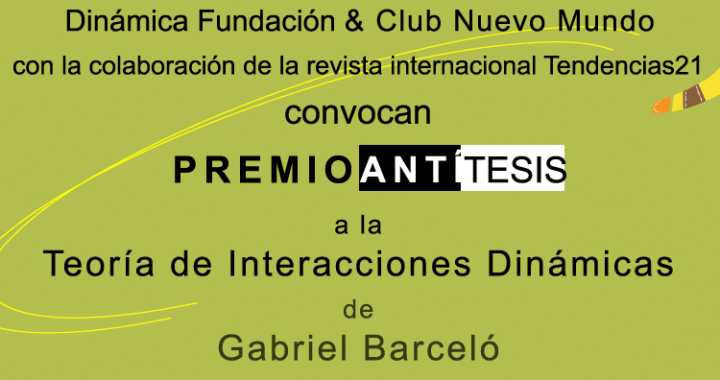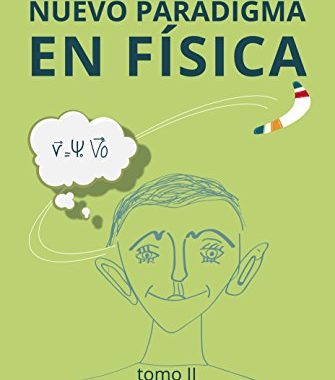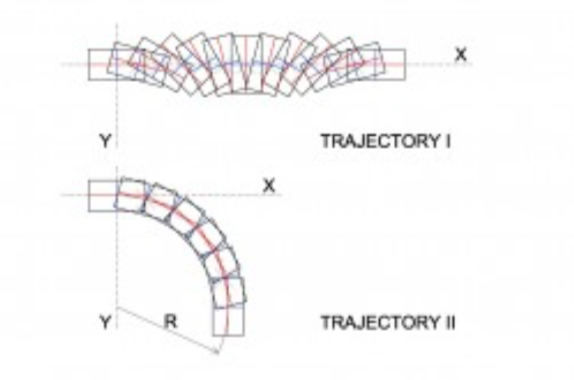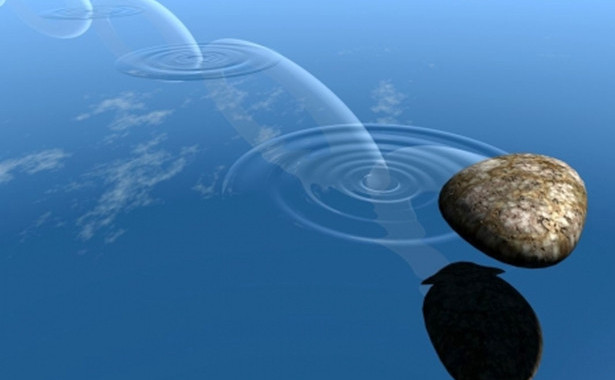¡Salta, piedrecita, salta!
Con este título ha sido publicado recientemente un breve artículo en una revista científica, 1 intentando justificar el comportamiento dinámico de las piedras que se tiran contra un espejo de agua, y rebotan. No obstante, en nuestra opinión, las ideas que se aportan en este texto no tienen ninguna base lógica, ni metodológica, y los argumentos que se expresan, no responden a un método científico riguroso.
El texto hace referencia a un estudio ya antiguo 2, que exponía condiciones y requisitos comprobados estadísticamente, pero que no analiza la causalidad o el origen de ese peculiar comportamiento de la naturaleza, conocido y utilizado desde antiguo para el ocio, e incluso, para la guerra.
Epostracismo
La piedra saltarina, o epostracismo, es un juego que consiste en lanzar una concha o piedra plana sobre el agua de forma que rebote sobre la superficie, preferentemente muchas veces. En la Grecia Clásica ya se practicaba este juego, e incluso hicieron un tratado oral explicando cómo las piedras lanzadas sobre el agua rebotaban una y otra vez.
Las piedras saltarinas sobre el agua han sido un pasatiempo popular a lo largo de miles de años. Para analizar la física de esta actividad ancestral humana, focalizamos el momento en el que la piedra rebota sobre la superficie del agua. Un ángulo de aproximadamente 20º entre la piedra y la superficie del agua es óptimo para las condiciones de lanzamiento, y para conseguir el rendimiento máximo en el número posible de rebotes.
Tradicionalmente ha sido asumido que la piedra genera una sustentación de la misma manera que un disco volante, pero esta justificación no tiene base científica. Tampoco la tensión superficial del agua justifica el comportamiento que observamos. Realmente existe confusión y desconcierto en el ámbito científico sobre este curioso comportamiento, dice el artículo que comentamos: Cuando un guijarro plano golpea la superficie del agua formando un pequeño ángulo, esta actúa como un rampa que lo impulsa hacia arriba. ¿A qué se debe? 3

Figura 1. Trayectoria resultante al chocar una piedra plana y con movimiento angular intrínseco, contra una lámina de agua
No parece sustentado en principios físicos esta argumentación de que el agua … actúa como un rampa que lo impulsa hacia arriba. Sin aportar el autor, a continuación, ningún argumento científicamente creíble.
El mismo autor Schlichting, propone unas condiciones o requisitos para que se produzca el fenómeno del rebote, pero no propone una justificación causal: Para conseguir que un disco así salte, es necesario conferirle, además de un vuelo recto hacia delante, una componente de movimiento hacia arriba a través de la interacción con el agua. Esto solo es posible por medio de una fuerza adecuada en el momento del impacto, de la cual dependerá que la pequeña losa se hunda o rebote con suficiente potencia.
Para que ocurra esto último, la piedra debe sobrevolar el agua con una trayectoria baja y de manera oblicua, con su lado plano ligeramente inclinado con respecto a la horizontal. Así pues, hemos de considerar dos ángulos relevantes: el ángulo de impacto que forma la trayectoria del centro de gravedad de la piedra con la superficie del agua en el momento de tocarla, y el de inclinación de su lado plano con respecto a la superficie del agua. 4

Figura 2. Ilustración de una piedra saltarina, siendo V la velocidad de la piedra, θ el ángulo de inclinación y el de incidencia β. Sim representa el área de contacto con la superficie del agua y el eje Z la profundidad de inmersión.5
En nuestra opinión, este es un supuesto de cuerpos sometidos a múltiples rotaciones, que no puede ser entendido en el ámbito de la mecánica clásica. El salto se produce si la piedra dispone de giro intrínseco. La rotación de la piedra nos permite deducir que es un claro ejemplo de cuerpo rígido sometido a dos rotaciones no coaxiales: la inicial y la debida a la resistencia del agua en el momento del impacto.
Este tipo de fenómeno queda plenamente justificado con la Teoría de interacciones Dinámicas.
Si tiramos un disco o, incluso, una piedra plana sobre un espejo de agua, ésta se hundirá, al igual que si la dejamos caer, debido a que es acelerada por la fuerza de la gravedad. Bien, pero si lanzamos la piedra, a la vez que le aplicamos un movimiento de rotación sobre su eje vertical, la piedra sorprendentemente salta sobre el agua y continua su avance, hasta que las fuerzas disipativas acaben con su movimiento. 6 (Ver figuras 1 y 2).
Partimos de la hipótesis de que el lanzamiento equivale al tiro parabólico de un proyectil. No podemos suponer, como en el caso del Bumerán, que el efecto de sustentación efectivo durante el desplazamiento de la piedra por el aire sea decisivo en nuestro análisis.

Figura 3. Sistema de referencia de la piedra.
Suponemos que lanzamos la piedra con una velocidad lineal  y con un ángulo inicial φ0 , a la vez que se le imprime una rotación, que la hace girar sobre su eje de simetría Z’ con velocidad angular constante ω.
y con un ángulo inicial φ0 , a la vez que se le imprime una rotación, que la hace girar sobre su eje de simetría Z’ con velocidad angular constante ω.
Rechazando los efectos de rozamiento con el aire, y suponiendo un espejo de agua idealmente plano, podemos proponer que en el momento del lanzamiento se inicia un movimiento parabólico en presencia del campo gravitatorio, ya que la única aceleración que existe es la de la gravedad. Las ecuaciones de la trayectoria del centro de masas de la piedra serán:

El movimiento parabólico continuará hasta llegar a la superficie de agua, entonces ocurre el hecho curioso, anteriormente mencionado de que la piedra, dotada de momento angular intrínseco, en vez de hundirse, salta sobre el agua comenzando un nuevo movimiento aparentemente parabólico, hasta que vuelva a caer, y se repita el fenómeno interactivamente, hasta que pierda su energía cinética.
Si observamos detenidamente el suceso, advertiremos que la trayectoria de la piedra varía, tras el choque con el agua, y varía de tal forma que pasa de una trayectoria descendente a una ascendente, adquiriendo de nuevo energía potencial, y perdiendo su equivalente en energía cinética.
A partir de cada choque con el agua, tendremos de nuevo una trayectoria semejante a la de un proyectil, resultado de la composición de la reacción inercial generada por el par instantáneo que se genera en el choque, y la velocidad de traslación del centro de masa de la piedra. Esta trayectoria se mantendrá hasta que la piedra, con rotación intrínseca, toque de nuevo el agua, momento en el que el fenómeno de interacción dinámica la hace de nuevo salir proyectada hacia arriba. Este proceso se mantendrá mientras que la piedra disponga de un giro intrínseco, en el momento que toque el agua, sin momento angular suficiente, se hundirá.7 Ver en la figura 3, el sistema de referencia de la piedra de nuestro análisis.
La causa de ese cambio en la trayectoria de nuestra piedra es, en nuestra opinión, la actuación de un par de fuerzas instantáneo, en el punto de contacto de la piedra con el agua, constituido por la fuerza de rozamiento en ese punto, y su peso. La piedra incide, con su rotación intrínseca, sobre el punto de contacto con cierta inclinación del eje Z’ respecto a la perpendicular al espejo de agua.

Figura 4. Diagrama resultante al chocar una piedra plana y con movimiento angular intrínseco, contra una lámina de agua.
El momento resultante no es nulo, puesto que debido a la reacción del peso en el punto de apoyo, aparece un momento que haría rotar a la piedra respecto de ese punto. Este momento, que no es coaxial con el correspondiente al giro intrínseco de la piedra, provoca la aparición de un fenómeno de Interacción Dinámica, que supondremos instantáneo, en una primera aproximación.
Este par generará una distribución interna de velocidades, que se acoplará con la velocidad lineal del centro de masas, iniciando una trayectoria ascendente. En este caso debe suponerse que la piedra tendrá una cierta inclinación respecto al plano de agua, produciéndose una fuerza de rozamiento tangencial, en el punto de contacto de la piedra con el agua, así como la fuerza -P de reacción al peso mg de la piedra (Figura 4).
El cuerpo dotado de momento angular  describe una trayectoria parabólica. En un instante, t1, termina su trayectoria inicial al llegar al punto de contacto con el agua, en el que se produce el par de fuerzas referido. Este par genera una variación del momento angular
describe una trayectoria parabólica. En un instante, t1, termina su trayectoria inicial al llegar al punto de contacto con el agua, en el que se produce el par de fuerzas referido. Este par genera una variación del momento angular  , no coaxial con
, no coaxial con  , por lo que se crea la distribución interna de velocidades que se acopla al vector velocidad de traslación, variando la trayectoria.
, por lo que se crea la distribución interna de velocidades que se acopla al vector velocidad de traslación, variando la trayectoria.
Si definimos la nueva velocidad  como la actuación del operador matemático ψ sobre el vector inicial
como la actuación del operador matemático ψ sobre el vector inicial  , tendremos:
, tendremos: 

Figura 5. Epostracismo: la piedra debe girar sobre un eje perpendicular a la superficie del agua.
El par de fuerzas creado por el peso y la reacción en el punto de apoyo, representa un momento respecto del centro de masa, que generaría una nueva rotación respecto del eje X’ del sistema del cuerpo. Debido a la existencia de una rotación previa respecto del eje Z’, no coaxial, y de conformidad con la teoría que se sustenta, el fenómeno de interacción dinámica determina la aparición de una distribución no homogénea de velocidades resultantes, que pudiera entenderse como un par de fuerzas de Interacción Dinámica, perpendicular al par del peso, y cuyo momento dinámico tiene la dirección del eje X’. Esa distribución no homogénea de velocidades se acopla con el vector velocidad de traslación, haciendo variar su dirección, es decir, genera un giro de la dirección del vector velocidad, siendo el eje de ese giro perpendicular al plano del movimiento. Ver ilustración de epostracismo en la figura 5.
Puesto que la variación de la dirección de la velocidad tiene una componente vertical, podemos suponer que el giro realizado es positivo, antihorario, de ángulo α. En el sistema de referencia de la piedra (Ver en la figura 3), tendremos que la matriz que representa al operador ψ tendrá la forma:

El vector velocidad  0 será de la forma:
0 será de la forma: 
de donde


Siendo esta la nueva velocidad del centro de masa de la piedra, que incorpora un vector de trayectoria ascendente, comenzando la piedra su nuevo movimiento parabólico.
En el supuesto de un modelo idealizado, sin fuerzas resistivas, la piedra seguiría perpetuamente con este movimiento, siempre y cuando tuviera el suficiente momento angular  para realizar el siguiente salto. En la realidad, las fuerzas disipativas, como puede ser el rozamiento con el aire y el agua, hacen que paulatinamente pierda tanto velocidad lineal como de rotación, llegando un momento en el que la inercia rotacional no sea suficiente, y la piedra acabe por hundirse.
para realizar el siguiente salto. En la realidad, las fuerzas disipativas, como puede ser el rozamiento con el aire y el agua, hacen que paulatinamente pierda tanto velocidad lineal como de rotación, llegando un momento en el que la inercia rotacional no sea suficiente, y la piedra acabe por hundirse.
Es importante destacar en este caso que el ángulo α, no es función continua del tiempo, o mejor dicho, será función del tiempo un brevísimo lapso t2– t1, durante el cual actúa el par externo. Por tanto, el efecto de interacción dinámica será también casi instantáneo, desapareciendo en el momento que la piedra eleva el vuelo, al no existir ya el par real del peso y la fuerza resistiva del agua.8
Bombas que rebotan
Basadas en este mismo fenómeno dinámico que acabamos de describir, durante la segunda guerra mundial fueron concebidas unas bombas específicas contra las presas de los embalses de agua.
Imaginemos un bidón, de forma cilíndrica, que es arrojado desde un avión hacia un pantano de agua, creado mediante una presa. Nuestro bidón viaja dentro del avión y en un determinado momento se abren sus compuertas, a modo de plano inclinado, y comienza el bidón a rodar por ese plano inclinado, debido a la acción de la gravedad. Una vez abandona la rampa, comienza un movimiento compuesto por uno de caída y otro horizontal con la velocidad del avión, es decir, una trayectoria parabólica descendente. El bidón, al caer rodando por la rampa del avión, es lanzado con una velocidad de rotación inicial ω, dextrógira según la figura 6. Además, de conformidad con la primera ley de Newton, continuará moviéndose con la velocidad inicial V1 que es la del avión que la transportaba.
El bidón al llegar a la superficie del lago saltará, al igual que salta la piedra, comenzando un nuevo movimiento ascendente hasta que se agote su energía potencial, instante en el que comenzará una trayectoria descendente hacia la superficie del lago, continuará así su movimiento hasta llegar a la presa, instante en el que cae rodando por el muro. Basados en este fenómeno, en la Segunda Guerra Mundial, fueron diseñadas bombas rasantes para atacar pantanos de agua, que se lanzaban desde aviones en vuelo a baja altura, para destruir las presas o muros de contención.

Figura 12.16. Bomba rasante lanzada contra una presa de agua.
Se trataba de bombas cilíndricas giratorias con una elevada velocidad de rotación, que se lanzaban desde el avión en vuelo rasante desde la cola del pantano hacia el muro de contención; el cilindro se hacía rodar dentro del avión, por la rampa desde la que se lanzaba, con su eje de simetría paralelo a la superficie del agua.
La bomba experimentalmente se habría comprobado que rebotaba sobre el agua del embalse, del mismo modo que lo hace una piedra plana cuando la lanzamos girando sobre su eje vertical sobre la superficie plana de un lago o río. Al llegar al muro, gracias a su elevada velocidad de rotación y a su peso, se sumergía rodando sobre la pared o por su peso, una espoleta retardada la hacía explotar a profundidad suficiente, produciendo graves daños en el muro. Se había conseguido un proyectil selectivo, con un alto porcentaje de efectividad, que destruía el blanco: el dique o muro, aunque se produjese la descarga de la bomba lejos del mismo. Hoy día se calificaría a este proyectil cómo inteligente, aunque realmente no disponía de ningún dispositivo de seguimiento electrónico. 9 (Ver figuras 6 y 7).

Figura 7. Recreación del fenómeno (Revista KIJK. Octubre 1996)
En un artículo Jean-Michel Courty y Edouard Kierlik, refiriéndose también a estas bombas de rebote, para justificar el comportamiento dinámico de las piedras sobre el agua, proponían unos criterios que no compartimos:
Las bombas fueron lanzadas desde una altura de 18 metros por aviones que volaban a 400 kilómetros por hora. Con una masa de más de cuatro toneladas, las bombas rebotaron varias veces sobre el agua, apenas hundiéndose mientras el muelle hidrodinámico se mantuvo activo. Pasaron así por encima de las redes de protección y recorrieron los aproximadamente 400 metros que las separaban de la presa. Al chocar con la pared, se deslizaban por ésta hacia el fondo, donde estallaban. 10
Como justificación teórica a este comportamiento, el autor alude al concepto de: “muelle hidrodinámico”, fenómeno que no puede ser integrado en la física, y que iría en contra del Principio de Pascal. El comportamiento de este artefacto es fácil de justificar al hacer un análisis dinámico del fenómeno, conforme a la teoría que se sustenta, comprobándose porqué la bomba, de elevado peso, no se hunde al contactar con el agua en su primer choque y, mientras dispone de rotación propia, continua su trayectoria de saltos, hasta golpear contra el muro y sumergirse.

Figura 8. Sistema de referencia del cilindro.
Podemos iniciar el análisis dinámico de estas bombas utilizando las hipótesis de la teoría que se sustenta. De nuevo rechazaremos los efectos de rozamiento con el aire. El cilindro chocará con la superficie de agua, idealmente plana, en un punto de su base. Supuesto el sistema de referencia en el cuerpo mostrado en la figura 8, inicialmente tenemos un cilindro con rotación ω respecto de su eje X’ de simetría, que cae desde cierta altura con una velocidad lineal inicial  , que era la del avión portador. La trayectoria del bidón sería, como ya hemos indicado, parabólica descendente, hasta llegar a la superficie del lago, momento en que ocurre el prodigio estudiado, el bidón no se hunde sino que es impulsado hacia arriba, variando su trayectoria, además de continuar con su movimiento de traslación. Sus velocidades iniciales de traslación y de rotación intrínseca se habrán reducido por razón del choque con el agua.
, que era la del avión portador. La trayectoria del bidón sería, como ya hemos indicado, parabólica descendente, hasta llegar a la superficie del lago, momento en que ocurre el prodigio estudiado, el bidón no se hunde sino que es impulsado hacia arriba, variando su trayectoria, además de continuar con su movimiento de traslación. Sus velocidades iniciales de traslación y de rotación intrínseca se habrán reducido por razón del choque con el agua.
En el momento de tomar contacto con el agua, se producirá una resistencia o fuerza de fricción instantánea que generará una desaceleración en ese punto, pivotando el cilindro sobre el punto de contacto.

Figura 9. Por efecto de interacción dinámica se inicia una trayectoria ascendente de precesión.
El artefacto, como en el caso del epostracismo, dispone de momento angular, dada su rotación, y de velocidad lineal, no obstante, en el momento de tomar contacto con el agua, aparece un nuevo momento instantáneo, que, conforme a la TID, genera un movimiento de precesión, haciendo variar la dirección de la velocidad de traslación, mediante un giro de valor α, respecto del eje X’ del cuerpo, iniciando así una trayectoria ascendente, hasta que la energía potencial adquirida supere a su energía cinética. En ese momento volverá a iniciar una trayectoria parabólica de caída, y así sucesivamente hasta llegar a la presa del pantano, en donde caerá rodando contra el muro hasta que explote, mediante una espoleta de presión (Ver figuras 6 y 7).
La falta de un par constante impedirá que el movimiento de precesión iniciado permita una orbitación completa, pero en el instante de choque con el agua, formarán un par el peso y la fuerza de rozamiento. Aplicando el concepto de interacción dinámica, se advierte que el efecto combinado de las fuerzas de peso y rozamiento instantáneo, genera un par no coaxial con el momento angular del cilindro, que impulsa al objeto, en rotación, a elevarse, (Figura 9).
La trayectoria es, paradójicamente, un movimiento alternativo, con una componente de precesión que se inicia en el momento de chocar con el agua, elevándose el artefacto, y cayendo de nuevo cuando su energía potencial adquirida iguala a la energía cinética. Este fenómeno será reiterativo, mientras disponga de rotación propia, o hasta alcanzar el muro de contención.

Figura 10. Diagrama de momentos y fuerzas.
La fuerza de rozamiento y el peso actúan como un par de fuerzas no coaxial con  (Figura 10). La fuerza de rozamiento tenderá a reducir la velocidad de rotación inicial angular del cilindro pero, simultáneamente, generara una torsión del eje de rotación, creándose las distribuciones de velocidades y aceleraciones características de una interacción dinámica, pero también en este caso, casi instantánea.
(Figura 10). La fuerza de rozamiento tenderá a reducir la velocidad de rotación inicial angular del cilindro pero, simultáneamente, generara una torsión del eje de rotación, creándose las distribuciones de velocidades y aceleraciones características de una interacción dinámica, pero también en este caso, casi instantánea.
Si aplicamos el modelo matemático de la TID, la velocidad inicial de traslación estará sometida a una rotación espacial definida por la matriz:

El vector velocidad  será de la forma:
será de la forma:

De donde:


Siendo esta la ecuación de la velocidad mientras se encuentre dotado de momento angular intrínseco, y en cada instante que se mantenga en contacto con la superficie del agua.11
Son por tanto, unas bombas cuyo comportamiento dinámico se justifica con la misma argumentación que hemos expuesto para el epostracismo, en el marco conceptual de la Teoría de Interacciones Dinámicas.
Caso de Par Instantáneo
Ambos ejemplos son casos de un par instantáneo que actúa sobre el sólido en rotación, y cuyo asombroso comportamiento fácilmente se comprende con la teoría que proponemos (TID).
Como hemos visto, en ambos casos, el comportamiento resultante del móvil previamente en rotación, sometido a un nuevo par instantáneo, era ya conocido, aunque su causalidad no estuviese debidamente justificada hasta ahora, pero el hecho es que estos fenómenos se utilizaban, y sus resultados eran aplicados en la guerra y en el ocio.
La Teoría de Interacciones Dinámicas (TID) también nos puede explicar otros muchos comportamientos que en su momento, han sido considerados como paradójicos. El análisis dinámico del giróscopo o de la peonza se caracteriza por el hecho de que el peso y la resistencia del punto de apoyo constituyen un par de acción, en este caso constante, y su comportamiento es también fácilmente explicable con la TID.





























